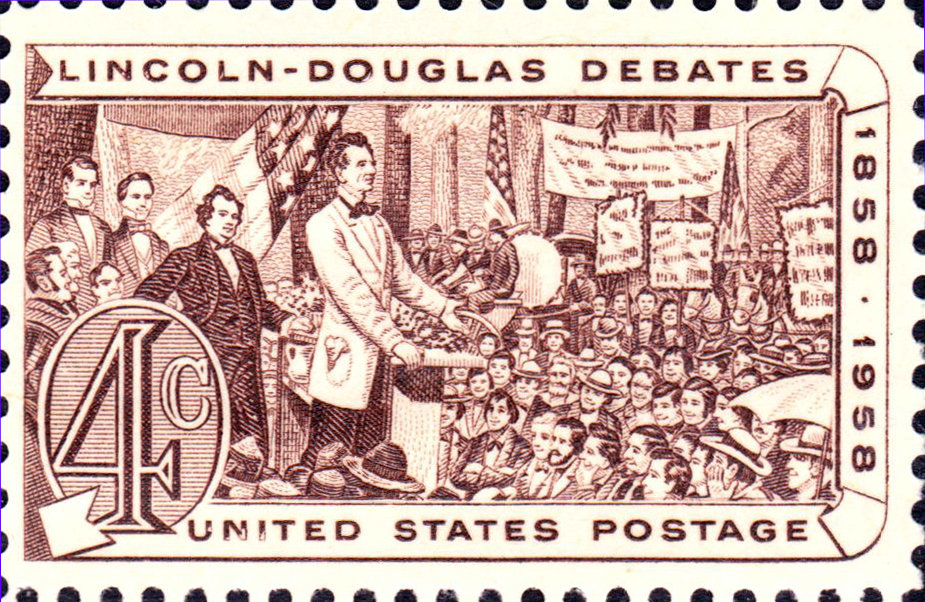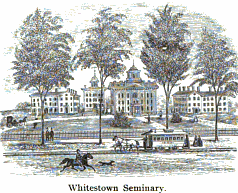|
Galesburg, Illinois
Galesburg is a city in Knox County, Illinois, United States. The city is northwest of Peoria, Illinois, Peoria. At the 2010 United States Census, 2010 census, its population was 32,195. It is the county seat of Knox County and the principal city of the Galesburg micropolitan area, Galesburg Micropolitan Statistical Area, which includes all of Knox and Warren County, Illinois, Warren counties. Galesburg is home to Knox College (Illinois), Knox College, a private four-year liberal arts college, and Carl Sandburg College, a two-year community college. A section of the city is listed on the National Register of Historic Places as the Galesburg Historic District. History Galesburg was founded by George Washington Gale, a Presbyterian minister from New York (state), New York state who had formulated the concept of the manual labor college and first implemented it at the Oneida Institute near Utica, New York, Utica, New York. In 1836 Gale publicized a subscription- and land purchase ... [...More Info...] [...Related Items...] OR: [Wikipedia] [Google] [Baidu] |
List Of Cities In Illinois
Illinois is a U.S. state, state located in the Midwestern United States. According to the 2020 United States census, Illinois is the List of U.S. states and territories by population, 6th most populous state with inhabitants but the List of U.S. states and territories by area, 24th largest by land area spanning of land. Illinois is divided into 102 County (United States), counties and, as of 2020, contained 1,300 Municipal corporation, municipalities consisting of cities, towns, and villages. The most populous city is Chicago with 2,746,388 residents while the least populous is Valley City, Illinois, Valley City with 14 residents. The largest municipality by land area is Chicago, which spans , while the smallest is Irwin, Illinois, Irwin at . List File:ChicagoFromCellularField.jpg, alt=Skyline of Chicago, Chicago is Illinois' most populous municipality. File:Paramount Theatre - panoramio.jpg, alt=Paramount Theatre, Aurora, Paramount Theatre in Aurora, Illinois, Aurora, Illi ... [...More Info...] [...Related Items...] OR: [Wikipedia] [Google] [Baidu] |
National Register Of Historic Places
The National Register of Historic Places (NRHP) is the Federal government of the United States, United States federal government's official United States National Register of Historic Places listings, list of sites, buildings, structures, Historic districts in the United States, districts, and objects deemed worthy of Historic preservation, preservation for their historical significance or "great artistic value". The enactment of the National Historic Preservation Act (NHPA) in 1966 established the National Register and the process for adding properties to it. Of the more than one and a half million properties on the National Register, 95,000 are listed individually. The remainder are contributing property, contributing resources within historic district (United States), historic districts. For the most of its history, the National Register has been administered by the National Park Service (NPS), an agency within the United States Department of the Interior. Its goals are to ... [...More Info...] [...Related Items...] OR: [Wikipedia] [Google] [Baidu] |
American Civil War
The American Civil War (April 12, 1861May 26, 1865; also known by Names of the American Civil War, other names) was a civil war in the United States between the Union (American Civil War), Union ("the North") and the Confederate States of America, Confederacy ("the South"), which was formed in 1861 by U.S. state, states that had Secession in the United States, seceded from the Union. The Origins of the American Civil War, central conflict leading to war was a dispute over whether Slavery in the United States, slavery should be permitted to expand into the western territories, leading to more slave states, or be prohibited from doing so, which many believed would place slavery on a course of ultimate extinction. Timeline of events leading to the American Civil War, Decades of controversy over slavery came to a head when Abraham Lincoln, who opposed slavery's expansion, won the 1860 presidential election. Seven Southern slave states responded to Lincoln's victory by seceding f ... [...More Info...] [...Related Items...] OR: [Wikipedia] [Google] [Baidu] |
Mary Ann Bickerdyke
Mary Ann Bickerdyke (July 19, 1817 – November 8, 1901), also known as Mother Bickerdyke, was a hospital administrator for Union (American Civil War), Union soldiers during the American Civil War and a lifelong advocate for veterans. She was responsible for establishing 300 field hospitals during the war and served as a lawyer assisting veterans and their families with obtaining pensions after the war. Early life Mary Ann Ball was born on July 19, 1817, in Knox County, Ohio, to Hiram and Annie Rodgers Ball. She is cited as one of the first women who attended Oberlin College in Ohio, but official records show no proof of attendance. In 1847, she married Robert Bickerdyke, who died in 1859, two years before the Civil War. Together, the Bickerdykes had two sons. She later moved to Galesburg, Illinois, where she worked as botanic physician and primarily worked with alternative medicines using herbs and plants. Bickerdyke began to attend the Central Congregational Church (Galesburg, ... [...More Info...] [...Related Items...] OR: [Wikipedia] [Google] [Baidu] |
Lincoln–Douglas Debates
The Lincoln–Douglas debates were a series of seven debates in 1858 between Abraham Lincoln, the Republican Party (United States), Republican Party candidate for the United States Senate from Illinois, and incumbent Senator Stephen Douglas, the Democratic Party (United States), Democratic Party candidate. Until the Seventeenth Amendment to the United States Constitution, which provides that senators shall be elected by the people of their states, was ratified in 1913, senators were elected by their respective state legislatures. Therefore, Lincoln and Douglas were trying to win the people's votes for legislators in the Illinois General Assembly, aligned with their respective political parties. The debates were designed to generate publicity—some of the first examples of what in modern parlance would be characterized as "media events". For Lincoln, they were an opportunity to raise both his state and national profile and that of the burgeoning Republican Party, newly organ ... [...More Info...] [...Related Items...] OR: [Wikipedia] [Google] [Baidu] |
Underground Railroad
The Underground Railroad was an organized network of secret routes and safe houses used by freedom seekers to escape to the abolitionist Northern United States and Eastern Canada. Enslaved Africans and African Americans escaped from slavery as early as the 16th century and many of their escapes were unaided. However, a network of safe houses generally known as the Underground Railroad began to organize in the 1780s among Abolitionist Societies in the North. It ran north and grew steadily until the Emancipation Proclamation was signed in 1863 by President Abraham Lincoln.Vox, Lisa"How Did Slaves Resist Slavery?", ''African-American History'', About.com. Retrieved July 17, 2011. The escapees sought primarily to escape into free states, and potentially from there to Canada. The network, primarily the work of free and enslaved African Americans, was assisted by abolitionists and others sympathetic to the cause of the escapees. The enslaved people who risked capture and thos ... [...More Info...] [...Related Items...] OR: [Wikipedia] [Google] [Baidu] |
Abolitionism
Abolitionism, or the abolitionist movement, is the political movement to end slavery and liberate enslaved individuals around the world. The first country to fully outlaw slavery was France in 1315, but it was later used in its colonies. The first country to abolish and punish slavery for indigenous people was Spain with the New Laws in 1542. Under the actions of Toyotomi Hideyoshi, chattel slavery has been abolished across Japan since 1590, though other forms of forced labour were used during World War II. The first and only country to self-liberate from slavery was a former French colony, Haiti, as a result of the Revolution of 1791–1804. The British abolitionist movement began in the late 18th century, and the 1772 Somersett case established that slavery did not exist in English law. In 1807, the slave trade was made illegal throughout the British Empire, though existing slaves in British colonies were not liberated until the Slavery Abolition Act 1833. In the U ... [...More Info...] [...Related Items...] OR: [Wikipedia] [Google] [Baidu] |
Mississippi River
The Mississippi River is the main stem, primary river of the largest drainage basin in the United States. It is the second-longest river in the United States, behind only the Missouri River, Missouri. From its traditional source of Lake Itasca in northern Minnesota, it flows generally south for to the Mississippi River Delta in the Gulf of Mexico. With its many tributaries, the Mississippi's Drainage basin, watershed drains all or parts of 32 U.S. states and two Canadian provinces between the Rocky Mountains, Rocky and Appalachian Mountains, Appalachian mountains. The river either borders or passes through the states of Minnesota, Wisconsin, Iowa, Illinois, Missouri, Kentucky, Tennessee, Arkansas, Mississippi, and Louisiana. The main stem is entirely within the United States; the total drainage basin is , of which only about one percent is in Canada. The Mississippi ranks as the world's List of rivers by discharge, tenth-largest river by discharge flow, and the largest ... [...More Info...] [...Related Items...] OR: [Wikipedia] [Google] [Baidu] |
Utica, New York
Utica () is the county seat of Oneida County, New York, United States. The tenth-most populous city in New York, its population was 65,283 in the 2020 census. It is located on the Mohawk River in the Mohawk Valley at the foot of the Adirondack Mountains, approximately west-northwest of Albany, east of Syracuse and northwest of New York City. Utica and the nearby city of Rome anchor the Utica–Rome metropolitan area comprising all of Oneida and Herkimer counties. Formerly a river settlement inhabited by the Mohawk Nation of the Iroquois Confederacy, Utica attracted European-American settlers from New England during and after the American Revolution. In the 19th century, immigrants strengthened its position as a layover city between Albany and Syracuse on the Erie and Chenango Canals and the New York Central Railroad. During the 19th and 20th centuries, the city's infrastructure contributed to its success as a manufacturing center and defined its role as ... [...More Info...] [...Related Items...] OR: [Wikipedia] [Google] [Baidu] |
Oneida Institute
The Oneida Institute ( ) was a short-lived Presbyterianism, Presbyterian school in Whitesboro, New York, United States, that was a national leader in the emerging Abolitionism in the United States, abolitionist movement. Existing from 1827 to 1843, the school was radical and the first that accepted both Black people, Black and White people, White students in the United States. According to Earnest Elmo Calkins, Oneida was "the seed of Lane Seminary, Case Western Reserve University#Western Reserve College (1826–1882) and University (1882–1967), Western Reserve College, Oberlin College, Oberlin and Knox College (Illinois), Knox colleges." The Oneida Institute was founded in 1827 by George Washington Gale as the Oneida Institute of Science and Industry. His former teacher (in the Addison County Grammar School, Middlebury, Vermont, 1807–1808) John Frost, now a Presbyterian minister in Whitesboro with Harriet Lavinia (Gold) Frost his wife — daughter of Thomas Ruggles Gold, — ... [...More Info...] [...Related Items...] OR: [Wikipedia] [Google] [Baidu] |
Manual Labor College
A manual labor college was a type of school in the United States, primarily between 1825 and 1860, in which work, usually agricultural or mechanical, supplemented academic activity. The manual labor model was intended to make educational opportunities more widely available to students with limited means, and to make the schools more viable economically. The work was seen as morally beneficial as well as healthful; at the time, this was innovative and egalitarian thinking. According to the trustees of the Lane Seminary: These "colleges" usually included what we would today (2019) call high school ("preparatory") as well as college-level instruction. At the time, the only public schools were at the elementary level, and there were no rules distinguishing colleges from high schools. The four states with the largest number of such schools were New York, Ohio, Indiana, and Illinois. George W. Gale George W. Gale was the founder of the first and best-known American example, th ... [...More Info...] [...Related Items...] OR: [Wikipedia] [Google] [Baidu] |








